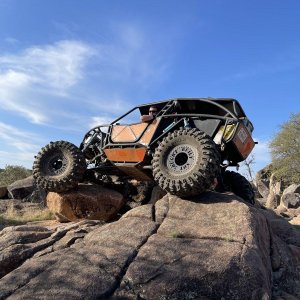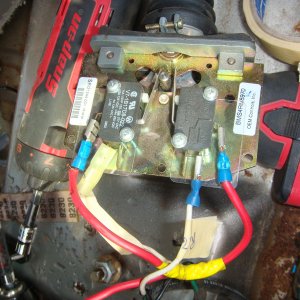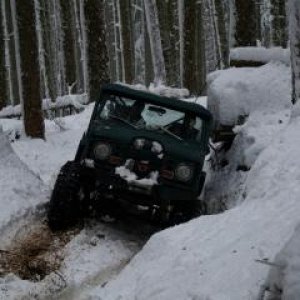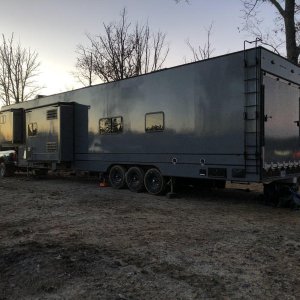this is a good thread. i thought i'd add my .02 in here, fwiw.
i tend to like long range trips, so some of the below items might not be applicable. But, on the other hand, as others are mentioning a small trip can always turn out to be a big one if things go wrong.
As i was relaying to my 5 year old the other day, while high-centered in snow at 4,000ft (stupid skid plate) always follow these rules for back country survival
1) go prepared
2) stay calm
3) use your head
4) keep a positive attitude, don't let small setbacks deter you! make a plan and execute.
maybe it's too simple, but I feel this is worth stating very clearly, especially for noobies.
onto my rant / advice -
rollovers, sliding off the trail, etc: it might look cool in pics of buggies wallowing around on their sides but rest assured, its no fun in a stock or even modified full-bodied rig and could hurt or kill someone if the vehicle doesn't have a cage.
get a lev-o meter in your rig, and get comfortable with what it can handle in a controlled environment.
don't be afraid to ask someone to tie off the B-pillar or a part of the cage to avoid a flop, or worse a barrell roll down a hill. if in doubt, go slower and tie off. how many rigs have been winched up out of the creek here lately? how many of those could have been avoided by using a little more noggin' and a little less throttle?
carry enough tools to get the job done: a winch is a good start, but it hardly constitutes a complete recovery setup. i tell n00b's to get the winch last and get the essentials first. winches are good for a straight-forward stuck. unfortunatley, those are few and far between! more often than not, something is broken, a rock is in a bad place, you're on a hill, or may even have 2 or more tires that decided to pop off a bead and make your rig lean in the wrong (scary) direction. sometimes, all of the above can be checked off. go prepared!
So, in addition to a high-lift, consider addint these items to your kit if you don't have them already:
- a shovel (even an "e-tool", aka trifold will work, and is compact)
- tree saw and/or axe
- extra d-shackles
- d-rings
- 25ft or 50ft winch extension rope
- tree strap; having 2 doesn't hurt
- kinetic strap
- a winch pulley if so equipped.
- 2 or more FRS radios or a hand-held CB
- large spotlight, small flashlights. LED's are lookin' sharp these days
- leather gloves. carry extras for helpers
- headlamp. indispensible for rigging in the dark. keep your hands free
- a couple short lengths of grade 70 chain with clevis hooks
- winch line weight. a spare tire can be used for this if steel cable is being used on the winch line and under severe load/conditions
- a hand winch!
- basic tool set.
- ratchet straps to hold things together if need be
- good first aid kit
- extra food and water
There are two brands of hand winches out there that are rated for dead-lifting. I would avoid come-alongs - the safety factor on come-alongs is not good compared to the two below, and quality can be spotty between manufacturers.
Tirfor (marketed as Griphoist in the US) is one, Wyeth-Scott makes the other, aptly named the "More Power Puller". The MPP costs alot less than the Tirfor, and can be a great addition to your recovery kit where you might need to stablize a vehicle from the rear or side while winching forward, to keep from sliding off the trail, down an embankment, or worse, off a cliff.
Tirfor:
more power puller: a solid $100 investment.
Pacific Industrial in Seattle is a great place to pick up extra D-shackles and winch hooks. buyer beware, not everything in the bins is rated for working load limit ... pass on it if it's not. I've seen Tirfor winches in there as well, if they look like something you're interested in carrying.
You can buy Samson brand synthetic ropes at many of the industrial marine stores. I bought mine in Magnolia. The steel eyelets and rope splicing were top notch - their customers lives depend on it! I was impressed with the results, and the price was fair.
a note on water - it's not a bad idea to get a couple jerry can mounts on your rig, and carry extra fuel and a jerry-can for water. i don't know about you, but redbull, a small container of gatoraid and maybe a victory end-of-trail beer usually win-out for trail fluids when I pack up for a day of wheelin'. If something goes wrong and you have to set to work, it's nice to know that you always have 20liters of fresh water on supply. Even in snow you can deyhdrate very quickly. With the adrenline pumping don't let it catch up to you - if you feel the least bit thirsty then drink some water, catch your breath and take a second to double-think your work strategy to make sure you're making progress in a safe manner.
tips on technique:
hooks!! whenever a hook is involved under load, situate the hook
throat down. this means that the opening of the hook is facing the ground. this way if the hook fails, it will send the shock down and not up. whenever possible, source hooks that include a safety clasp over the throat of the hook.
if you do find yourself needing to secure the side of the vehicle to avoid a roll-over, there are a few things to keep in mind.
treat the rope or wire-rope securing the side just like a winch line under load. it very well may end up supporting the weight of the vehicle depending on the situation.
do not cut corners on rigging - rig it up just as you would a winch line.
if anchoring the side off to a fixed point, keep in mind that the vehicle will want to move in a radius. you need a way to let the line out and allow the rig to take up the slack as forward progress is made to avoid rerigging every few feet. the hand-winch comes into play here as a great tool for this purpose. trying to use a hi-lift is not nearly as effective or easy to handle, but can be done if used with extreme caution, and the rigging on the tongue of the high-lift is made secure.
use a tree strap to find a good anchor point and place the hand-winch near the anchor with a d-ring or shackle. do not wrap the cable around any part of the vehicle and try securing it with the hook! either use another short strap and connect the ends to the hook with a d-shackle, or barring that, use a chain and choke the chain to the required length with the correct style hook for the chain's size. connect the end of the chain then to your tether.
allow a couple feet of slack in the line and let the driver drive the rig forward, or winch forward depending on the situation. if a roll-over is immenent, winching forward, even downhill (btdt) is preferable as it is more controlled. as slack is taken up, radio to the driver or winch-operator to stop, and then let a few more feet of slack out on the line.
coordinating a recovery is much easier if you can can communicate clearly between participants. FRS radios or a hand-held CB are great for this purpose. you can't always see hand-signals through tree-cover or in the dark, and they are prone to being misinterpreted.
suppliers - as mentioned above, Pacific Industrial is a good place to kick around. For online vending, ExpeditionExchange.com is among the most complete, carrying all of the items listed above and a whole lot more. the owners are knife and gun freaks as well, which will probably appeal to many of you

check 'em out.
keep organized! i'm the worst at this and I pay almost every time i run into trouble

for toolbags and emergency camping stuff, Federal Army Surplus is a good source. they sell some sweet first-aid tri-folds and have heavy duty canvas tool bags. a couple MRE's and one of those small Esbit solid-fuel stoves are good to keep in the rig at all times for your work-food supply.
visit them downtown, or navigate over to
http://www.gr8gear.com/
$11
$4 - esbit stove, good for heating up an MRE
hope someone finds this useful
cheers
-isaac













